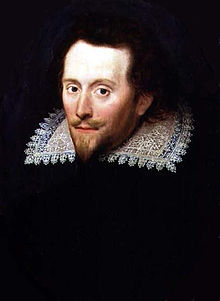
Back وليام كافنديش دوق نيوكاسل الاول ARZ William Cavendish, 1. vévoda z Newcastle Czech William Cavendish, 1. Duke of Newcastle German William Cavendish (1592-1676) Spanish William Cavendish (1er duc de Newcastle) French William Cavendish, I duca di Newcastle-upon-Tyne Italian ウィリアム・キャヴェンディッシュ (初代ニューカッスル公) Japanese William Cavendish (1592-1676) Dutch William Cavendish, 1.º Duque de Newcastle-upon-Tyne Portuguese Кавендиш, Уильям, 1-й герцог Ньюкасл-апон-Тайн Russian
The Duke of Newcastle upon Tyne | |
|---|---|
 Portrait by William Larkin, c. 1610 | |
| Lord Lieutenant of Nottinghamshire | |
| In office 1660–1676 | |
| Lord Lieutenant of Derbyshire | |
| In office 1628–1638 | |
| MP for East Retford | |
| In office 1614–1620 | |
| Personal details | |
| Born | c. 16 December 1593 Handsworth, South Yorkshire, England |
| Died | 25 December 1676 (aged 83) Welbeck, Nottinghamshire, England |
| Resting place | Westminster Abbey |
| Spouse(s) | Elizabeth Howard (1599–1643) Margaret Lucas (1623–1673) |
| Relations | William, Earl of Devonshire (1590–1628) Sir Charles Cavendish (1594–1654) |
| Children | Jane (1621–1669) Charles (1626–1659) Elizabeth (1626–1663) Henry, 2nd Duke of Newcastle (1630–1691) Frances |
| Parent(s) | Sir Charles and Lady Catherine Cavendish |
| Alma mater | St John's College, Cambridge |
| Occupation | Courtier, arts patron, soldier |
| Military service | |
| Allegiance | |
| Years of service | 1642—1644 |
| Commands | Royalist commander for the North |
| Battles/wars | |
William Cavendish, 1st Duke of Newcastle upon Tyne, KG, KB, PC (c. 16 December 1593 – 25 December 1676), who after 1665 styled himself as Prince William Cavendish, was an English courtier and supporter of the arts. He was a renowned horse breeder, as well as being patron of the playwright Ben Jonson and the intellectual group known as the Welbeck Circle.
Despite spending the then enormous sum of £15,000 entertaining Charles I in 1634, he failed to gain a significant political post. In the early stages of the First English Civil War, he was appointed Royalist Captain-General in Northern England; he financed much of the war effort himself, later claiming this totalled in excess of £1,000,000. After the defeat at Marston Moor in July 1644, a battle fought against his advice, he went into exile in Europe.
He returned to England after the Stuart Restoration in 1660, and although created Duke of Newcastle in 1665, he remained on the fringes of the court and became critical of Charles II. He died in 1676 and was buried in Westminster Abbey.[1]
- ^ Stanley, A.P., Historical Memorials of Westminster Abbey (London; John Murray; 1882), p. 242.